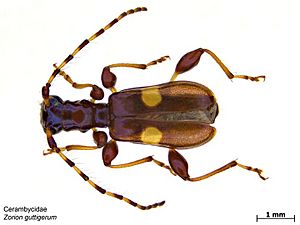Bascantis facts for kids
Quick facts for kids Bascantis |
|
|---|---|
| Scientific classification | |
| Kingdom: | |
| Phylum: | |
| Class: | |
| Order: | |
| Family: | |
| Genus: |
Bascantis
Meyrick, 1914
|
| Species: |
B. sirenica
|
| Binomial name | |
| Bascantis sirenica Meyrick, 1914
|
|
Bascantis sirenica is a special kind of moth found only in New Zealand. It's the only species in its group, or genus, called Bascantis. This moth belongs to a family of moths known as Tineidae. Scientists don't have enough information about this moth, so the Department of Conservation lists it as "Data Deficient." This means we need to learn more about it to understand how well it's doing.
Contents
Who discovered this moth?
This unique moth was first described by a scientist named Edward Meyrick in 1914. He used a specimen, which is a collected example, that was found by George Hudson in January at a place called Kaeo. George Hudson later wrote about and showed pictures of this moth in his books, including The Butterflies and Moths of New Zealand (1928) and Fragments of New Zealand entomology (1950). The original specimen, called a holotype, is kept safe at the Natural History Museum, London.
What does this moth look like?
The Bascantis sirenica moth is quite small, about 12 millimeters long. Its head and body are a deep purple color, with a whitish face. Its antennae are violet-fuscous, and its abdomen is a dark bluish-grey.
The front wings are long and somewhat narrow, with a deep purple color. They have a semi-oval (half-egg shaped) yellowish-white spot in the middle of the front edge. The back edge of the wing has several small, shiny blue spots and tiny whitish dots. There's also a narrow, bright purple band with a metallic blue shine near the wing tip. The wing edges are dark grey. The back wings are dark bronze-fuscous, meaning a dark brownish-grey with a metallic sheen, and are lighter towards the front.
Where does this moth live?
This moth is endemic to New Zealand, meaning it's found nowhere else in the world. Besides Kaeo, where it was first discovered, it has also been seen in other places like the Waitākere Ranges, Days Bay, and Wainuiomata. The last time this moth was officially seen was in 1950, which makes it a very rare and mysterious creature!
How does this moth behave?
Adult Bascantis sirenica moths are active in January. Unlike many moths that fly at night, this species is a day-flying moth. Scientists have a theory that this moth might be a "mimic." This means it could look like another animal to protect itself. In this case, it's thought to mimic the appearance of a beetle called Zorion guttigerum.
What is its habitat?
This moth has been found by sweeping nets through dense forest areas. This suggests it lives in thick, wooded environments.
Why is its conservation status "Data Deficient"?
The Bascantis sirenica moth is listed as "Data Deficient" under the New Zealand Threat Classification System. This classification means that scientists don't have enough information or data to properly assess if the moth is endangered or not. More research is needed to understand its population size, where it lives, and what threats it might face.


